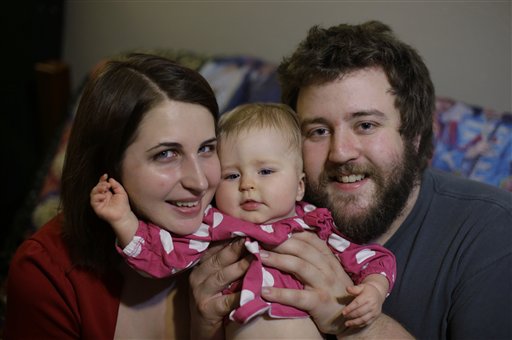By HOPE YEN
Associated Press
WASHINGTON
No longer taboo, living together has become a more common arrangement for America’s couples who become pregnant while dating.
Soon-to-be-released government figures show a major cultural shift since the days of “shotgun weddings” aimed at avoiding family embarrassment. With marriage on the decline, the shift is helping redefine the traditional notion of family.
Still, she cautions that children in cohabiting households may face more difficulties growing up if their unmarried parents are at higher risk of breaking up.
In all, the share of unmarried couples who opted to have “shotgun cohabitations” _ moving in together after a pregnancy _ surpassed “shotgun marriages” for the first time over the last decade, according to a forthcoming paper from the National Center for Health Statistics, part of the Centers for Disease Control and Prevention. The trend was affirmed by three demographers who conducted separate research on the topic.
It’s the latest demographic tipping point as cohabitations turn mainstream _ a far cry from the days when the father of a pregnant daughter might use coercion, such as a shotgun, to make sure the boyfriend followed through on a wedding.
An unplanned pregnancy quickly changed that. Completing an associate degree, she agreed to have Gage move in so the couple could work and save on rent while raising Zoey together. Even though they didn’t see marriage as a serious option for now _ in part to avoid the additional stress of planning and paying for a wedding, she says _ neither was having Pulte live on her own as a single mother.
The numbers are based on the government’s National Survey of Family Growth, typically issued every four years. It provides the only government data on cohabiting mothers by asking questions on a woman’s relationship status before and after conception and childbirth. Women who say they were single before conception and then married before childbirth are counted as someone who had a post-conception, or “shotgun” marriage; those who moved in with their boyfriends after pregnancy had a post-conception or “shotgun” cohabitation.
Demographers say the cohabiting trend among new parents is likely to continue. Social stigma regarding out-of-wedlock births is loosening, and economic factors play a role. Many couples, especially those who lack a bachelor’s degree, are postponing marriage until their finances are more stable. But because of globalization, automation and outsourcing, good-paying middle-income jobs are harder to come by.
About 18.1 percent of all single women who became pregnant opted to move in with their boyfriends before the child was born, according to 2006-2010 data from the government’s National Survey of Family Growth, the latest available. That is compared to 5.3 percent who chose a post-conception marriage.
As recently as the early 1990s, 25 percent of such couples got married.
Cohabiting mothers are spurring increases in out-of-wedlock births, now at a high of 41 percent. In all, about 60 percent of all births during the 2000s were to married mothers, compared to 24 percent to cohabiting mothers and 16 percent to non-cohabiting mothers. That was the first time that cohabiting births exceeded births from single mothers who weren’t living with their child’s father.
Since the early 1990s, the share of out-of-wedlock, cohabiting births has grown from 11 percent to 24 percent, while those to noncohabiting, single mothers has remained steady at 16 percent.
Sometimes referred to as the “poor person’s marriage,” cohabitation is growing fastest among high school graduates with children. Between the 1997-2001 and 2002-2009 periods, it grew from 23 percent to 32 percent, according to Sheela Kennedy, a researcher at the University of Minnesota. For mothers with some college attendance, it grew from 15 percent to 23 percent over that period. Among those with four-year college degrees, the share has changed little, from 3 percent to 5 percent.
Daniel Lichter, a Cornell sociologist and past president of the Population Association of America, said the government needs to do more to reflect increasing cohabitation in statistics. Cohabitation status is not included on birth certificates, and that can skew policy debates over the government safety net for poor households. It also means a growing trend of fragile families in which cohabitating parents may be more likely to break up can be neglected, he said.
Researchers at Harvard and Cornell universities have found that only about half of mothers who were cohabiting when their child was born were still in relationships with the biological father five years later. “The latest results seem to indicate that marriage, as a context for childbearing and childrearing, is increasingly reserved for America’s middle- and upper-class populations,” Lichter said.

COMMENTS
Please let us know if you're having issues with commenting.